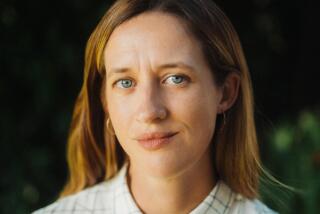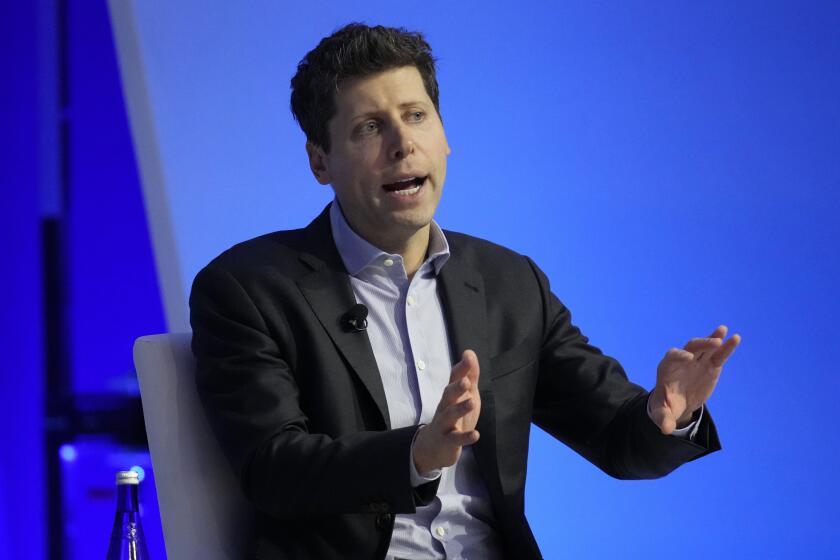THE SUNDAY PROFILE : A Big Math Attack : Jan Davidson turned a lifelong passion for teaching into a multimillion-dollar software corporation. But she hasn’t let her new life as a successful businesswoman draw her away from her true love.
- Share via
Twelve years ago, Jan Davidson was exactly where she wanted to be--in a classroom.
She had known since age 13--when she began tutoring other children after school--that she wanted to teach.
Her home life was on track as well. Davidson and her husband, Bob, were raising three preteen children in Palos Verdes. His career as a corporate executive was on a meteoric climb.
But Davidson had a vision that would forever alter their lives: Why not use a home computer to teach kids math?
It’s not a radical notion today, but at the time only a handful of educational software programs were available, and almost none of them were widely used.
“They were dull and if a kid missed something they would make this horrible ‘beep,’ ” Davidson says with disdain. “Here you had this powerful tool for teaching and all you were giving a kid was negative feedback every time they hit the wrong key. And it was loud enough that everyone in the room knew that Johnny had made a boo-boo.”
Davidson’s computer experience was limited to an Apple II--woefully primitive by today’s standards--purchased in the late 1970s. But she believed that if educational software could be as exciting as computer games, she might use it to good advantage in the classrooms where she ran an after-school tutoring service.
She sat down at her Apple with a friend who knew a bit about programming and created a game for grade-school students called “Math Blaster.”
“Whenever you got an answer right, you’d shoot a man out of a cannon,” Davidson explains. Kids loved Math Blaster. Their parents wanted to buy copies to run on home computers.
“There was no ‘beep.’ ”
Davidson began selling the software through her tutoring service, and later via a catalogue distributed by Apple.
Her kids--Elizabeth, now 23, Emilie, 20, and John, 18--were her first workers. When an order came in, they used her computer to copy the discs. Their mom used an unwieldy shrink-wrap machine (“I hated that thing,” she says) to give the little packages a finished look.
Davidson, 50, still sells “Math Blaster.” But instead of asking her kids to do the work, she now has a team of employees--about 500 in all. They work in a sleek, modern building--with her name across the top--in a Torrance industrial park.
Last year, Davidson & Associates racked up almost $60 million in sales. The original “Math Blaster” and its update have sold 1.6 million copies, making it the world’s second most successful educational software title--behind the “Carmen Sandiego” series.
“It’s nice that I got rich,” Davidson says. “But honestly, it wasn’t my main objective. All I wanted to do was to teach kids.”
If she is daunted by the events of the last 12 years, she hides it well. Dressed in a plain red jacket and simple gold necklace--more parent-teacher night than corporate executive--she speaks almost shyly about her financial success.
Erin Yoshida comes into the office to set up a software demonstration. Davidson rushes over to her.
“You are wonderful!” the boss says. “I have not given you your hug yet.”
She embraces a beaming Yoshida. It is not a David Viscot-style, touchy-feely ‘90s hug, but a sincere expression of appreciation.
Yoshida, a 25-year-old who majored in fashion merchandising in college, coordinated the recent release of “Multimedia Workshop,” a program that allows kids--and adults, for that matter--to create presentations incorporating photographs, drawings, text and even video.
“She got that program through testing and out the door,” Davidson says with pride.
“We like to have people here who are not savvy computer users to work on our manuals and programs,” she adds, “because those of us who use them all the time might be jaded. Someone outside of the business would be more reflective of the average consumer.”
Yoshida leaves the sparsely furnished office done in variations of gray and Davidson returns to the table.
“I used to always think of education as something you did with kids,” Davidson says. “Now I realize you learn all your life. I get a lot of satisfaction out of watching people grow.
“I think I enjoy building the people as much as I do doing the products.”
*
Davidson grew up in Frankfort, Ind., a town that claims it gave birth to the hot dog. Her father distributed dairy products to grocery stores. Davidson, the oldest of three children, was a star student, but she did take time out for Indiana’s overriding passion--high school basketball games.
“Of course I went to the games,” she says, incredulous that anyone would even have to ask. “It’s what you did in Indiana.”
What kids didn’t do is read heady tomes on educational theories. “Even then I was reading these books on pedagogy by John Dewey,” she says. “I was always fascinated by education.
“I often get the question now, ‘Would you have done something different if you were growing up today?’ ” noting that many women of her generation went into teaching. “And I really don’t think I would have.”
She attended Purdue University “because it was not far from home.” Her first weekend there, she met Bob Davidson at a mixer. They married a week after she got her bachelor’s degree in 1966. (She later earned a master’s in communications and a doctorate in American literature, and taught at the community college level, while continuing to tutor.)
Over the next 10 years, the couple moved three times--and each of those times, she was pregnant.
“When we got to California in 1976, I said to Bob, ‘No more moves and no more babies.’ ” They settled into a home in Palos Verdes where they still live.
Wherever they lived, Davidson tutored at home, a couple of students at a time.
“When you are working one on one, that’s when you can actually see the moment the kid gets it,” she says, clapping her hands.
“I would work to get those moments.”
*
In the wake of Proposition 13, the 1979 tax-cutting measure that caused such a panic that some school administrators decided to end the school day at noon, Davidson founded Upward Bound. She headquartered her nonprofit tutoring service in a leased classroom at a Palos Verdes elementary school.
“It mushroomed right away,” Davidson says. “People didn’t know what to do with their kids all afternoon, and they were afraid that they would slip behind in schoolwork.”
To keep up with the demand, she hired teachers to oversee courses ranging from SAT preparatory seminars to remedial math. Upward Bound started out as a service for high school students, but as it grew in popularity, Davidson added classes for second-graders all the way up to adults. At its peak, during the 1983-84 school year, about 3,000 students took at least one class at Upward Bound.
At about the time she launched Upward Bound, Davidson bought her Apple II, thinking it could be used to replace the numerous machines used in a speed reading course. On a computer, she figured, the same exercises could be customized to the individual students.
She needed a program for the course and that need begat “Speed Reader.” Next came “Word Attack” for vocabulary, and then “Math Blaster.”
When orders came in, the household would go into a disk duplication and shrink-wrap frenzy.
Recently, while cleaning the room of her son, John, she came upon a business card he had made for himself about 10 years ago.
“He wrote in his little handwriting, ‘John Davidson--Best Disk Duplicator in the World.’ ”
Davidson breaks into a big smile and shakes her head. “He really was a good disk duplicator. I took the card and put it in his baby book.”
The day the first order for 100 programs arrived, she finally turned over production to a professional.
In 1984, a year after Apple picked up the programs, the company went out of the mail-order business. Davidson thought this would be a good time for her to get out of the software business. She decided to turn her venture over to a software publisher so she could get on with her tutoring and simply collect royalties.
“Bob was very successful in his career, he was working long hours and traveling a lot,” she says. “I already had enough on my plate.”
Bob Davidson, who was executive vice president of the Parsons international engineering and construction firm in Pasadena, believed that his wife would be miserable with the fate of her programs in another’s hands. But her mind was set, and the couple scheduled a meeting with a San Diego-based publisher. They were to meet at a Tiny Naylor’s restaurant in San Clemente.
The publisher never showed, and Bob took the opportunity to hammer home his argument.
“He said I would never be happy turning over these programs to someone who didn’t care or know as much about education as me,” Jan recalls.
On the drive home, she finally acquiesced.
They later learned that the publisher had not stood them up. He had gone to a different Tiny Naylor’s on the other side of San Clemente.
*
Davidson waves to the receptionists at the front desk of Davidson & Associates and heads out the door. She walks at a fast clip, heading for an office four blocks away where the company has rented additional space.
Wearing low heels, she takes shortcuts across lawns of other buildings.
“I always plan a little too much to do in the day,” she says.
The company has spread to three buildings and the home office is being remodeled to accommodate state-of-the-art multimedia studios.
Davidson & Associates went public in 1993, after a series of buyout offers. One came just a couple years after Davidson started the company--using $6,000 from savings set aside for her children’s college education (“You can imagine what it did to me to take out that money,” she says).
“I think they wanted to pay $2 million,” she says. “Bob was really floored. It was beyond his expectations.”
But Davidson would not entertain offers.
“I told Bob I hadn’t even gotten started yet.”
As other companies realized that there was big money to be made in the educational software market, Davidson & Associates got a lot of big-name competition. CBS, for example, announced that it was jumping on the bandwagon.
“I think CBS and others tended to look down and say, ‘Who is this little schoolteacher out there making a couple of products?’ ” Bob Davidson says. “They should have never underestimated her.”
The biggest difference between the competition and Davidson, industry observers say, is her passion for education.
“There were a lot of companies back then that had the view that they were in the software business,” says Phil Adam, co-founder of the computer game company Spectrum Holobyte. “Jan considered that she was in the education business, and that made all the difference.”
Or as Ken Walsh, president of the Software Publishers Assn., puts it: “Jan didn’t just know her customers, she was the customer.”
After introducing more than 50 educational products, CBS pulled out of the business after just a couple of years.
Davidson & Associates is now producing new products at a faster clip than CBS did. But all products have to meet Jan Davidson’s standards for what a student and/or teacher would truly like and need. It makes for long hours.
“Bob and I kind of made a decision early on that what we would be willing to give up in our lives was an active social life,” she says. “That wasn’t so hard for me, because I get so much more satisfaction out of my work and my family than I do anything else.”
Although they contribute to several educational foundations, they are not on the charity party circuit. They seldom even go to the movies. “I spend so little time at home,” Jan says, “I’m very jealous of that time. If I want to see a movie, we’ll wait for it to be on video.”
Bob Davidson, 51, left Parsons in 1989 to join Davidson & Associates as its CEO. He looks after all the operations and financial aspects of the company, freeing Jan to oversee research and development of the products.
Bob Davidson is currently on a cross-country bicycle trip with John--a high school graduation present. But before he left, he said he didn’t have to worry about being completely out of touch with the office.
“I’ll have a cellular phone on my bike,” he said.
Arriving at the leased office space, Jan sits down to get a quick demonstration of a new software product, in progress, developed by an outside group for the Davidson label.
“Oh, wow!” she says, clearly impressed by the opening title screen of the program.
But it’s downhill from there. “I’m not sure about the design,” she says to the project manager, a longtime Davidson employee.
“I think the composition is very weak.”
She quickly pulls other employees and even a visiting photographer over to the computer to get their opinions. Several times, she assures the project manager that her critical remarks might be premature.
“Maybe I’m overreacting to what they have done,” Davidson says, but it’s clear that everyone in the room is carefully weighing her reactions.
“I have to say I’m disappointed,” she says, finally. “I’m sorry I could not be more positive.”
On the way back to the office, Davidson walks quickly, but this time she is mostly quiet. “That one is scary,” she says. The product is not coming along as she had hoped.
Sometimes outside contractors provide the company with a welcome dose of new creativity. Sometimes not.
“I have to go back to the office and check the contracts,” she says.
Davidson may be known in the business as the schoolteacher who made good in the business world. “But no one,” Bob Davidson notes, “should underestimate her business sense.”
She has said in several recent speeches that technology, correctly applied, could help transform the embattled education system in this country. “As I visit schools throughout the country and talk with educators, I sense that our schools are preparing kids for a workplace that no longer exists,” she said in the keynote address before the National Educational Computing Conference last year.
“The majority of our schools are still set up to teach kids how to work in an Industrial Age. But the world these kids are going to face is an Information Age.”
Of course, she fully expects that Davidson & Associates will be a leader, if not the leader in putting multimedia educational products in the schools and homes.
But for Davidson, the most satisfactory experiences in education are still one on one.
“This is a place where you can make mistakes,” she says, addressing a group of 30 new employees in a motel conference room across the street from company headquarters.
Although almost all these new hires are in their 20s or 30s, they are a varied lot, from dressed-for-success business-affairs types to T-shirt-wearing warehouse workers.
Davidson works the room like a classroom, wandering among the attentive new employees as she talks.
“This is a place where you should make lots of mistakes,” she continues. “I used to have a sign in my schoolroom that said, ‘If you don’t make 10 mistakes a day, you aren’t trying hard enough.’
“We don’t want you to be afraid to take a risk. Of course, we generally don’t like it if you make the same mistake over and over again.”
The employees laugh.
“But the way you learn is by making mistakes.”
“I know that,” she tells them. “I’m a teacher.”
Jan Davidson
Age: 50
Native: No. Born and raised in Frankfort, Ind., lives in Palos Verdes.
Family: Married in 1966 to Bob Davidson, with whom she has three children.
Passions: Helping children learn.
On working as a tutor: “When you are working one on one, that’s when you can actually see the moment the kid gets it. I would work to get those moments.”
On the financial success of her company: “It’s nice that I got rich. But honestly, it wasn’t my main objective. All I wanted to do was to teach kids.”
On her business strategy: “We like to have people here who are not savvy computer users to work on our manuals and programs. . . . Someone outside of the business would be more reflective of the average consumer.”
On employing 500 people: “I used to always think of education as something you did with kids. Now I realize you learn all your life. I get a lot of satisfaction out of watching people grow.
More to Read
Inside the business of entertainment
The Wide Shot brings you news, analysis and insights on everything from streaming wars to production — and what it all means for the future.
You may occasionally receive promotional content from the Los Angeles Times.











